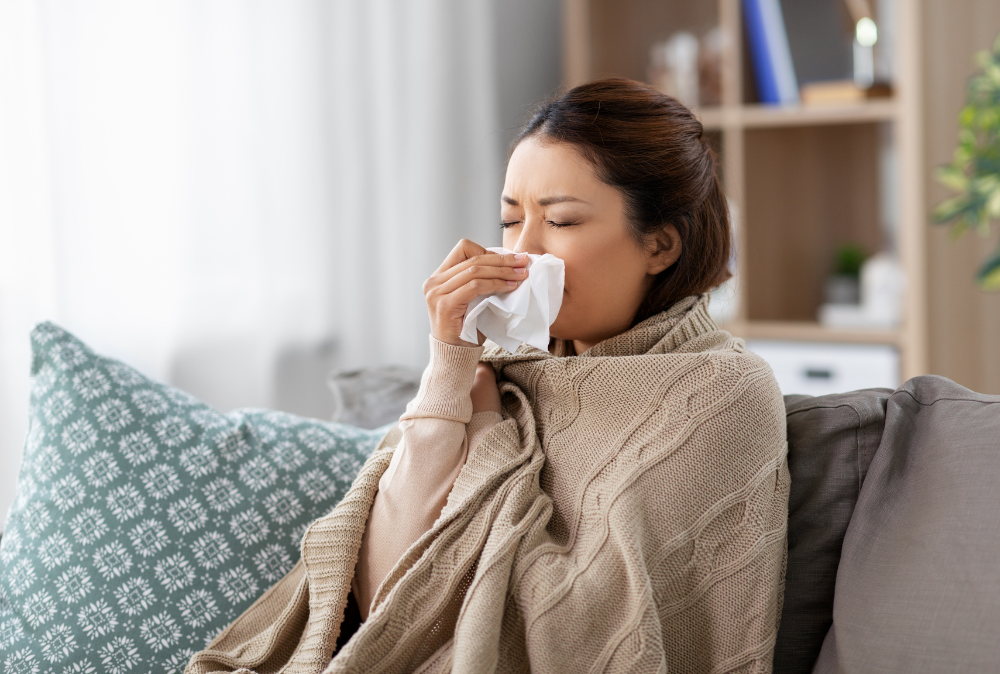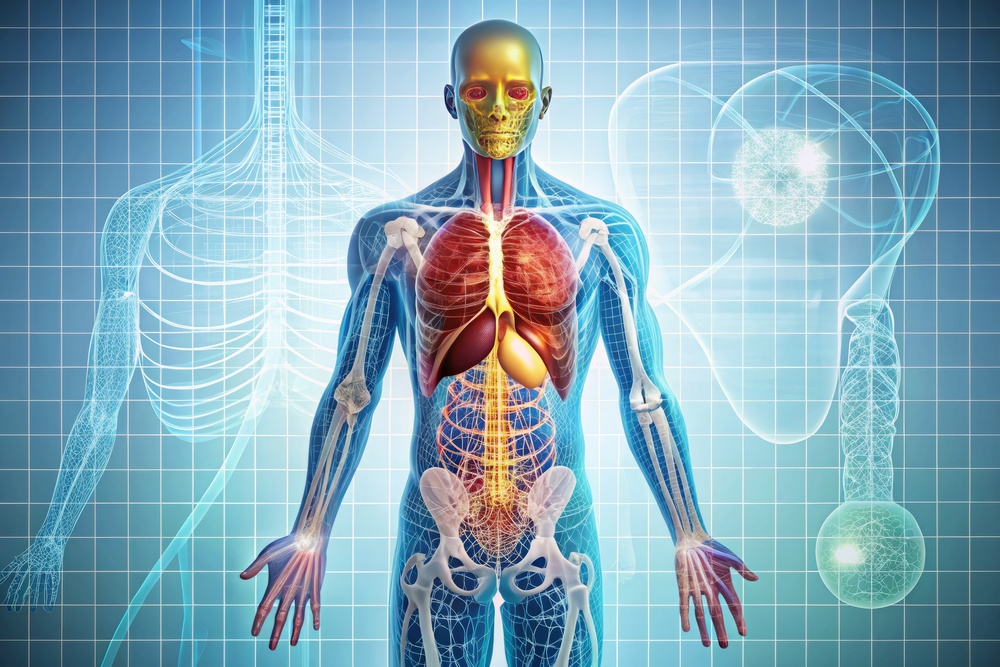
At KindlyMD, we believe in practical, evidence-based approaches to health — especially when it comes to something as familiar and frustrating as the common cold. While this ailment is rarely serious, it certainly can be uncomfortable. Here’s a breakdown of what happens, how it’s treated, and how you can support yourself (or a loved one) through those sniffles and coughs.
The common cold is a mild viral infection of the upper respiratory tract — a collection of viruses (most commonly rhinoviruses) that invade the nose and throat, causing symptoms like runny or stuffy nose, sore throat, cough, mild fatigue and sometimes low-grade fever.
Most people will recover from a cold within 7-10 days. But because there are hundreds of different cold-causing viruses, there is no single “cure” yet. Your body’s immune system ultimately clears the infection; our role is to help navigate the discomfort and avoid complications.
Usually, the common cold will resolve on its own and you can soothe the symptoms at home. Medical attention is rarely needed unless symptoms worsen or persist.
However, there are warning signs to watch for: if you develop a high fever, symptoms last more than about 10 days, you have underlying health conditions (like asthma or a weakened immune system), or you experience difficulty breathing or dehydration — then it’s time to reach out to a healthcare provider.
It’s also worth noting that antibiotics do not treat the common cold (since it’s viral, not bacterial), and misuse of antibiotics leads to resistance and other harms.
While you can’t “cure” the cold (the virus still needs to run its course), you can support your comfort and recovery in several meaningful ways:
If you find yourself with a cold, take a mindful approach. Start by acknowledging that your body is working to clear a virus. Provide rest, hydration, and comfort. If your symptoms include a sore throat, runny or stuffy nose, mild cough and possibly some fatigue, use safe symptom-relief measures (see above) and monitor your progress. Avoid over-the-counter or herbal treatments that lack evidence unless you’ve discussed them with a healthcare provider.
Keep prevention in mind for the next round — commit to good hand hygiene, healthy sleep and nutrition, and minimize exposure when possible. And finally, if you notice red-flags (very high fever, breathing trouble, symptoms lasting too long), seek professional care.
Remember: the common cold comes for us all. But you don’t have to face it unprepared. With the right balance of rest, care and awareness, you can ride it out — and be ready to move on with your life.

In our digital age, the internet often feels like the first stop when something feels off with our health. A quick search can provide countless explanations for a headache, fatigue, or stomach discomfort. This habit, colloquially termed cyberchondria, is the compulsive use of online health information to interpret personal symptoms. While it may seem harmless, self-diagnosis like this can be far more dangerous than most realize.
Cyberchondria often amplifies anxiety rather than easing it. People with heightened concern about their health can find themselves spiraling into unnecessary worry after browsing online symptom checkers or health forums. Research shows that extended online searches for medical information are associated with increased stress and functional impairment, particularly in those already prone to health anxiety.
The risk of self-diagnosis lies in the ease of misinterpreting symptoms. A simple headache could indicate dehydration, stress, or something far more serious. Without medical training, distinguishing between these possibilities is extremely difficult, and assuming you know the answer can lead to inappropriate treatment or delayed care. Misdiagnosis can allow a condition to worsen, and relying on the internet instead of professional guidance may even result in dangerous outcomes. For example, chest discomfort might be dismissed as indigestion when it could signal a heart condition — delays in proper care can be life-threatening. Beyond physical health, the psychological toll of misdiagnosis can be severe, increasing stress, panic, and feelings of helplessness.
Only a healthcare professional can accurately interpret symptoms in the context of a person’s medical history and overall health. Doctors have the training, experience, and access to diagnostic tools needed to distinguish between conditions that might appear similar online but require very different treatments. Consulting a professional ensures that you receive the right care at the right time, avoiding unnecessary complications or anxiety.
The internet can be a useful tool for understanding potential health issues, but it should never replace professional medical evaluation. Reading about conditions online can inform and educate, but assuming a diagnosis based on internet research alone is risky.
Ultimately, while curiosity about our own bodies is natural, self-diagnosis through online searches can do more harm than good. When concerns arise, seeking professional care is the safest and most effective way to protect your health and peace of mind. Your wellbeing deserves more than guesswork from a search engine — it deserves expert attention. True clarity about your health comes from a conversation with a qualified healthcare provider who can provide guidance tailored to you. Schedule an appointment today.

When people talk about gut health, it often sounds like a buzzword. But it’s not just about avoiding stomachaches or feeling comfortable after meals. The gut — and the trillions of microbes that call it home — plays a role in immunity, metabolism, even mood. Taking care of your gut is one of the most powerful ways you can support your overall well-being.
At its core, gut health refers to the balance and function of the microorganisms in your digestive system. This community, known as the gut microbiome, works with your body in ways we’re only beginning to understand. Research shows that a healthy gut is diverse, stable, and protective — it helps maintain the gut barrier, regulate inflammation, and produce beneficial compounds that affect everything from nutrient absorption to brain chemistry.
When the microbiome is disrupted, however, it can contribute to health issues. Scientists have linked gut imbalance, or dysbiosis, with autoimmune diseases, metabolic disorders, mood changes, and more. That’s why keeping your gut in good shape matters for much more than digestion.
The gut is home to a large portion of your immune system. Friendly bacteria “teach” immune cells to tell the difference between safe and harmful substances. When things are working smoothly, this training helps prevent unnecessary inflammation. But when the system is off balance, the immune response can go into overdrive.
Your gut also plays a role in metabolism and weight. The microbiome helps break down food, extract energy, and regulate fat storage. Studies have shown that certain microbial patterns are linked to obesity and type 2 diabetes. And then there’s the gut-brain axis — a two-way communication system where gut bacteria send signals to the brain through nerves, hormones, and metabolites. Some even produce compounds that influence mood and stress responses.
Even the gut lining itself depends on a thriving microbiome. The intestinal barrier prevents harmful substances from leaking into the bloodstream. When the barrier is weakened, inflammation can spread throughout the body.
Despite the gut’s resilience, modern life often challenges it. Diets heavy in ultra-processed foods and low in fiber are a big factor. Overuse of antibiotics can wipe out beneficial bacteria. Chronic stress, poor sleep, and lack of movement also play a role, gradually changing the balance of microbes in the intestines. And as we age, or as chronic conditions develop, the microbiome can become less diverse.
The good news is that gut health responds to care. You don’t need drastic overhauls; even small, consistent changes make a difference. Choosing meals rich in plants — colorful vegetables, fruits, beans, whole grains, nuts, and seeds — nourishes beneficial microbes. These fibers act as “prebiotics,” feeding the bacteria that produce short-chain fatty acids to support gut and immune function.
Adding fermented foods like yogurt, kefir, sauerkraut, or kimchi introduces live cultures that may help maintain microbial balance. Gentle movement, restorative sleep, and mindful stress management all nurture your microbiome as well. And while probiotics and prebiotic supplements can be helpful in some cases, they’re not one-size-fits-all. It’s wise to talk with a healthcare provider before starting them, especially if you have health conditions.
Your gut is not a machine that needs fixing — it’s more like a garden that thrives when you tend to it with patience and consistency. Caring for gut health isn’t about perfection; it’s about curiosity, small acts of nourishment, and a willingness to listen to your body. With each thoughtful step, you support not just your digestion but your immunity, your mood, and your overall vitality.
Most gut issues improve with lifestyle support, but there are times when professional guidance matters. Persistent abdominal pain, unexplained weight changes, blood in the stool, or ongoing fatigue are all reasons to connect with a doctor. A gastroenterologist or nutrition specialist can help with testing, diagnosis, and personalized strategies. Make an appointment with the KindlyMD Care Team today.

Back-to-school mornings. Work deadlines. Holiday shopping lists. This time of year can feel like one long race from task to task — and sometimes, physical activity is the first thing to fall off the schedule.
But here’s the good news: staying active doesn’t have to mean adding one more big “to-do” to your already packed day. With a little creativity and kindness toward yourself, you can weave movement into your routine in small, manageable ways that still make a big difference.
Even a little physical activity goes a long way:
The bottom line? You don’t need hours at the gym. A few intentional minutes sprinkled throughout your day can be powerful.
Here’s an easy, realistic way to keep physical activity in your day — even when life’s busy:
It doesn’t have to be complicated, it just has to be something.
The most important thing? Keep it compassionate. Movement isn’t about perfection — it’s about giving your body and mind a little love.
And remember, staying active is just one piece of your overall well-being. Things like managing chronic pain, improving sleep, and even nutrition support all work hand-in-hand with movement to help you feel your best.
During the busy season, physical activity doesn’t need to be another stressful obligation. Think of it as a way to recharge. Just a few minutes here and there to breathe, move, and reconnect with yourself.
Because at the end of the day, movement is a gift you give yourself. And you deserve it.
Ready to take the next step toward a healthier, more balanced you? At KindlyMD, our compassionate team is here to support your whole-person health. Whether you need guidance with pain management, wellness planning, or just want help creating a realistic routine, we’re here for you.
Book an appointment today and let’s create a plan that fits your busy life.

Managing your health shouldn’t feel overwhelming or mysterious. Thanks to wearable technology, patients now have a way to keep tabs on their well-being in real time — without needing to visit a doctor’s office every time something feels off. Whether you're navigating chronic pain, monitoring blood pressure, or trying to get more steps in, wearable devices are putting more control into your hands (or onto your wrist).
Wearable technology includes smart devices like fitness trackers, smartwatches, biosensors, and even patches or rings that monitor your health. These devices collect data such as heart rate, sleep patterns, physical activity, blood oxygen, and more — giving you (and your care team) a fuller picture of what’s going on inside your body.
And the best part? Many wearables sync directly with your smartphone or health apps, making it easy to track your progress over time or share insights with your provider.
For patients living with chronic conditions like diabetes, hypertension, or heart disease, wearable tech can be a game changer. Instead of guessing or waiting for symptoms to flare up, you can now catch warning signs early — and take action fast.
Here’s how:
Wearables don’t just track what’s happening now — they help you stay one step ahead. Researchers are studying how sensors can detect early signs of infection, dehydration, or inflammation. These tiny red flags might show up in your heart rate, temperature, or sleep cycles before you even feel sick.
For many users, wearable tech is just as valuable for supporting healthy habits:
A review in The Lancet Digital Health found that people using wearables tended to walk more, sleep better, and lose weight — especially when using them consistently over time.
Many wearable devices can now sync with your healthcare provider’s systems, making your appointments more productive and personalized. Instead of trying to remember how you’ve felt over the past month, you can show them your data.
Just keep in mind that some devices may share sensitive health info. If you're syncing with your provider, make sure the app or device follows HIPAA rules for privacy and protection. The U.S. Department of Health and Human Services offers guidance on how HIPAA protections work.
Wearable technology isn’t just for techies or fitness fanatics. It’s a tool for anyone who wants to feel more informed, more in control, and more connected to their health. Whether you're managing a chronic condition or just trying to stay on top of your wellness goals, wearables offer real-time insights that support long-term healing and prevention.
And remember — you’re not in this alone. If you’re curious about using wearable technology to support your treatment plan, the KindlyMD team is here to help you find solutions that are tailored to you. Schedule an appointment today.

When the sun is shining and temperatures soar, it’s time to trade winter layers for sunscreen and beach towels. But before you head outdoors, it’s crucial to take a few precautions to protect your health. Whether you're planning a hike, a pool day, or a summer road trip, these summer safety tips will help you stay safe, hydrated, and sun-smart all season long.
The summer sun feels great, but too much UV exposure can lead to painful burns, premature aging, and increase your risk of skin cancer. According to the American Academy of Dermatology, daily sun protection is key, especially between 10 AM and 4 PM when the rays are strongest.
Tips to protect your skin in the summer:
Pro Tip: Check the UV index each day using your phone’s weather app or EPA’s UV Index tool to help plan safer outdoor activities.
Dehydration is no joke in the summer heat. Whether you're working outdoors or just spending time under the sun, your body loses fluids faster. CDC guidelines recommend drinking water consistently throughout the day — don't wait until you're thirsty.
Hydration hacks:
Whether you're hitting the trails or running errands, it’s easy to overdo it in the summer heat. Heat exhaustion and heat stroke are serious conditions that require immediate attention. Even healthy people are at risk of heat exhaustion — but especially children, older adults, and those with chronic conditions.
Activity safety tips in hot weather:
If someone exhibits these symptoms, get them out of the heat, offer cool water, and seek medical help if symptoms worsen.
Accidents happen, especially when outdoor fun is involved. Having some basic first aid knowledge can make a big difference in an emergency. Keep a stocked first aid kit in your car, backpack, or beach bag. The Red Cross has a helpful guide on what to include.
Top summer first aid tips:
Summer is all about enjoying life outdoors — but preparation is the key to making the most of it. With these summer safety tips, you’ll be ready to soak up the season while protecting and preserving your health and well-being.
Looking to really boost your wellness levels this season? Sign up for our newsletter to receive seasonal health updates, expert advice, and more. Or better yet, schedule an appointment with one of our compassionate Care Providers for a head-to-toe tune up. Stay safe out there!

In today’s fast-paced world, many people neglect routine health screenings, often prioritizing other aspects of life over their well-being. However, regular screenings are a critical component of preventive healthcare, helping to detect potential health issues early, when they are most treatable.
A health screening is a medical test or series of tests designed to identify potential diseases or conditions before symptoms appear. These can include blood tests, imaging exams, and physical assessments tailored to a person’s age, gender, and risk factors. Early detection through regular screenings can lead to better treatment outcomes and, in many cases, can prevent diseases from progressing.
While specific screenings depend on individual health status, family history, and lifestyle, here are some general recommendations:
Health screenings play an essential role in maintaining overall wellness and preventing serious diseases. By prioritizing regular check-ups, individuals can take proactive steps toward a healthier future. Don’t wait for symptoms to appear — schedule an appointment today and stay ahead of potential health risks.

February is National Heart Health Month, so there's no better time to raise awareness about cardiovascular wellbeing and encourage individuals to adopt heart healthy habits. A healthy heart rate is crucial for overall cardiovascular health as it sets the pace for how efficiently your heart functions. Follow along as we discuss several strategies to help you achieve and maintain a stronger heart.
Regular exercise strengthens the heart muscle, improves blood circulation, and helps to maintain a healthy weight. The American Heart Association recommends at least 150 minutes of moderately intense aerobic activity per week, like speed walking, cycling, or swimming. This level of activity can help lower your resting heart rate over time.
Good cardiovascular health stems from a nutritious diet. Consuming a balanced diet of fruits, vegetables, whole grains, lean proteins, and healthy fats keeps your heart in good shape by maintaining healthy cholesterol levels and blood pressure. Foods high in omega-3 fatty acids, like salmon and flaxseeds, may also support a healthy heart rate. You'll want to limit your intake of saturated fats, trans fats, sodium, and added sugars.
Don't forget to hydrate with (and without) all that nutritious food. Dehydration can cause the heart to pump and work harder, speeding up your heart rate. Make sure you drink enough water throughout the day, especially when spending time exercising or out in warm weather.
Chronic stress may contribute to an increased heart rate, elevated blood pressure, heart disease, and obesity, according to a study by the National Heart, Lung, and Blood Institute. Try practicing stress reduction techniques like mindfulness, meditation, intentional breathing, yoga, or other relaxing and fulfilling hobbies to manage stress levels. When you are calm and steady, your heart tends to be, too.
Adequate sleep is essential for a healthy heart rate. During non-REM sleep, you heart rate slows down and your blood pressure drops, allowing your heart to relax. Aim for at least 7 hours of quality sleep per night. If you struggle falling or staying asleep, natural light exposure, minimal screen time before bed, and a cool, dark sleeping environment might help.
Smoking and excessive alcohol consumption can elevate your heart rate and increase the risk of heart disease over time. Quitting smoking and moderating alcohol intake can significantly improve your cardiovascular health. Of course, we recognize that quitting or reducing these things is often easier said than done. There's no shame in seeking help — ask your healthcare provider for resources and tips.
------------------------------------------------------------
Incorporating these strategies into your daily routine can help you reach and maintain a healthy heart rate, improving your overall cardiovascular health. Even small, consistent changes can lead to significant long term benefits. For help getting started, schedule an appointment with the KindlyMD Care Team today.

We have an old adage in English that says, 'there is more than one way to skin a cat'. Similarly, there is more than one way to approach healthcare. An approach we are incredibly enthusiastic about here at KindlyMD is known as integrative healthcare. We think it is something everyone should at least take a good look at.
Integrative healthcare is a different way to look at providing care for patients. It is considered a comprehensive approach to medicine, an approach that seeks to combine conventional treatments with complementary therapies. Complementary therapies tend to be evidence-based.
The nice thing about integrative healthcare is that it isn't limited to only a few medical conditions and diseases. It is an approach to healthcare that can be applied in nearly every situation.
Have you looked into integrative healthcare? If not, here are five great reasons to do so:
Integrative healthcare is holistic by its nature. The holistic concept revolves around treating the patient as a whole person rather than just focusing on a particular illness or medical condition. Holistic treatments are rooted in the understanding that people are more than just their physical bodies.
An integrative approach aims to treat the mind, body, and spirit together. It resists the temptation of focusing only on symptoms. The end result is a more comprehensive care plan that hopefully results in a better outcome.
Because integrative healthcare is holistic, providers are more likely to recommend a combination of treatments and therapies. Here at KindlyMD, we might recommend a combination of plant-based medicines, mental health counseling, and physical therapy to manage chronic pain. We believe that combining all three gives the patient the greatest chances of experiencing maximum pain relief.
Our favorite aspect to integrative healthcare is the fact that it is patient centric. The KindlyMD philosophy says that patients should always be in control. They should always have the final say in the treatments and therapies they utilize. But it is more than that.
Integrative medicine dictates that a patient's thoughts, emotions, and opinions have value. They need to be considered whenever decisions are being made. The end goal of applying a patient-centric approach is ensuring that the patient participates in their own care. When that happens, outcomes tend to be better.
Complementary therapies are a big part of integrative healthcare. Moreover, they are not frowned upon or considered last-ditch efforts to make a patient happy. Complementary therapies are actually welcome in an integrative environment.
Integrative healthcare emphasizes the use of evidence-based complementary treatments. However, there remains some disagreement within integrative circles about what constitutes evidence. The most sensible approach combines both clinical and anecdotal evidence for a more complete picture of a complementary therapy's usefulness.
Last but not least, integrative healthcare is collaborative. It doesn't rely on a single provider taking on full responsibility for patient care. More often than not, integrative care is provided by teams that include doctors, advanced practice nurses, registered nurses, therapists, and a variety of specialists. They are all aided by support staff capable of contributing their own knowledge and skills.
There is more than one way to provide healthcare services to patients. Both clinicians and patients have their preferences. But based on our experience, integrative healthcare tops the list. An integrative approach looks to combine every available resource with a team effort to ensure the best possible outcome for the patient.
